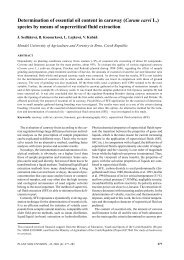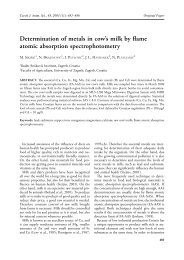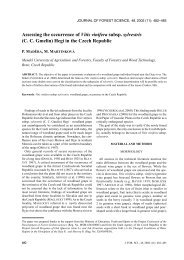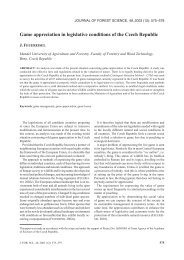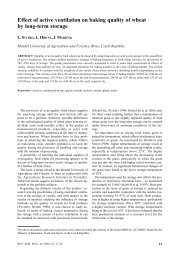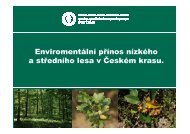fulltext - Agricultural Journals
fulltext - Agricultural Journals
fulltext - Agricultural Journals
Create successful ePaper yourself
Turn your PDF publications into a flip-book with our unique Google optimized e-Paper software.
Czech J. Genet. Plant Breed., 42, 2006 (3): 95–102<br />
The Potential of Common Cereals to form Retrograded<br />
Resistant Starch<br />
DANIELA MIKULÍKOVÁ 1 , MICHAELA BENKOVÁ 1 and JÁN KRAIC 1,2<br />
1 Research Institute of Plant Production, Piešťany, Slovak Republic; 2 University<br />
of SS. Cyril and Methodius, Trnava, Slovak Republic<br />
Abstract: Resistant starch (RS) has been recognised as a functional fibre with many health-promoting effects.<br />
RS exists in four forms – RS 1<br />
, RS 2<br />
, RS 3<br />
, and RS 4<br />
. The RS 3<br />
type is generated by amylose retrogradation typically<br />
resulting from food processing procedures. The aim of this study was to demonstrate the potential ability of six<br />
agriculturally important cereals to generate type RS 3<br />
resistant starch after retrogradation of their amylose. In<br />
comparison with all tested cereals, the statistically significant highest level of RS 3<br />
(5.28% ± 0.68) was detected in<br />
triticale, mainly in the Pinokio, Presto, Tricolor, and Kendo cultivars. Significant highly content was also found<br />
in rye (4.93% ± 0.73), especially in Selgo, Esprit, Dankowskie Nowe, and Apart cultivars, in comparison with<br />
wheat, spring and winter barley, tritordeum and oat. There were unsignificant differences between triticale and<br />
rye in RS 3<br />
levels. Wheat contained less RS 3<br />
(3.87% ± 0.55) in comparison to triticale and rye. The best wheats<br />
with this trait were the Athlet, Boka, Trane, Versailles, and Torysa cultivars. The content of RS 3<br />
in barley was<br />
not high (2.35% ± 0.45 in winter barley, 2.51% ± 0.25 in spring barley), similar to tritordeum (2.26% ± 0.36). The<br />
RS 3<br />
content in high amylose barley mutant Glacier was two-fold higher than in other tested barley cultivars<br />
(P < 0.01). Only minimal level of RS 3<br />
can be generated from oat seed starch (0.41% ± 0.09). These results indicate<br />
that plant species as well as crop cultivar screening are important for the identification of suitable natural<br />
sources of resistant starch. Concerning the production of functional foods, it is important to recognize that<br />
valuable bread cereals such as wheat and rye are superior sources of this type of dietary fibre and are highly<br />
beneficial to the human health. However, it is advisable to continue for other years in these annual results and<br />
localities too.<br />
Keywords: resistant starch; wheat; barley; rye; triticale; tritordeum; oat<br />
The reduction of food carbohydrate intake and<br />
low-carb diet has increased the interest in products<br />
containing resistant starch (RS) as a low-carb<br />
ingredient. RS has been recognised as a source<br />
of functional fibre with an important role in the<br />
physiology of digestion. Due to its physiological<br />
effects, RS has also been considered a prebioticum<br />
(ANNISON & TOPPING 1994) with multiple<br />
health-promoting effects. Metabolites which arise<br />
during its fermentation, particularly short-chain<br />
fatty acids, are necessary for normal physiological<br />
bowel function (SILVESTER et al. 1995). Butyrate<br />
resulting from this process is an important source<br />
of energy for colonocytes and also activates cell<br />
proliferation (MORTENSEN & CLAUSEN 1996).<br />
RS represents a barrier with both protective and<br />
nutritive functions, protecting against the development<br />
of colorectal cancer and aiding in the<br />
deterrence of ulcerative colitis (HILL 1995). Foods<br />
abundant in RS have a low (GI) glycemic index<br />
(LILJEBERG & BJÖRCK 1994) and are capable of<br />
preserving normal glucose (WILLETT et al. 2002),<br />
Supported by the Ministry of Agriculture of the Slovak Republic, Project No. 2003 SP27/028 OE 02/028 OE 02.<br />
95
Czech J. Genet. Plant Breed., 42, 2006 (3): 95–102<br />
insulin (PEREIRA et al. 2002), triacylglycerols, and<br />
cholesterol (LIU et al. 2001) blood concentrations<br />
in humans. A prolonged low-GI diet also protects<br />
against the development of non-insulin dependent<br />
diabetes mellitus (BJÖRCK et al. 2000) as well as<br />
cardiovascular diseases (BEHALL & HOVE 1995)<br />
in healthy subjects. RS will become a component<br />
of functional foods (NIBA 2002), defined as foods<br />
similar in appearance to conventional foods, consumed<br />
as part of a normal diet but which demonstrate<br />
physiological benefits and/or reduce the<br />
risk of chronic diseases beyond basic nutritional<br />
functions (HUGGETT & SCHLITER 1996).<br />
RS has been defined as the sum of starch and<br />
products of starch degradation not absorbed in<br />
the small intestine of healthy humans (ENGLYST &<br />
KINGMAN 1992) and escaping enzymatic digestion<br />
in the small intestine. Based on the mechanism<br />
that prevents this digestion, RS is classified into<br />
four types, namely RS 1-4<br />
(EERLINGEN & DELCOUR<br />
1995). Type RS 3<br />
resistant starch is of particular<br />
interest. This type is produced by gelatinization<br />
followed by retrogradation of starch molecules.<br />
The dispersed amylose and amylopectin molecules<br />
spontaneously re-associate and form crystallites<br />
resistant to enzymatic digestion upon cooling (SIE-<br />
VERT & POMERANZ 1989). Retrograded RS 3<br />
generally<br />
results during food processing that utilize heat<br />
and moisture (conservation, baking, cooking) and<br />
subsequent cooling (storage, refrigeration, freezing).<br />
The most important source of RS, and especially<br />
RS 3<br />
, includes the starchy seeds of cereal and legume<br />
species exploited for ingredient and food production.<br />
The path to functional foods containing RS 3<br />
begins<br />
with the potential of plant species and cultivars to<br />
create starch with different ratios of amylose and<br />
amylopectin. No relevant information exists within<br />
the published scientific literature on the potential of<br />
the most important agricultural crops to generate<br />
RS 3<br />
retrograded resistant starch, and consequently<br />
to contribute to the functionality of produced foods.<br />
The content of retrograded RS 3<br />
in six underutilized<br />
crops was analysed in our earlier study (MIKULÍKOVÁ<br />
et al. 2005). In this study, it was demonstrated that<br />
the highest potential for RS 3<br />
generation was found<br />
in chickpea and buckwheat seeds. Both crops are<br />
insufficiently utilized for food production, mainly<br />
in developed countries, and the aim of this study<br />
was to determine and compare the content of RS 3<br />
,<br />
soluble and total starch, respectively, in seeds of<br />
commonly grown cereals crutially exploited by the<br />
food industry.<br />
MATERIAL AND METHODS<br />
Seed samples of 98 cultivars and lines of six<br />
analysed cereals were used for starch characterization.<br />
The seeds of 22 wheat (Triticum aestivum<br />
L.), 32 barley (Hordeum vulgare L.), 11 rye (Secale<br />
cereale L.), 13 triticale (X Triticosecale Wittmarck),<br />
9 tritordeum (Tritordeum Aschers & Graebn) and<br />
12 oat (Avena sativa L.) cultivars were analysed. All<br />
cultivars (excepting high amylose barley mutant<br />
Glacier) were grown in the locality of Piešťany<br />
and harvested in the summer of 2003.<br />
Groats from all analysed plant species were<br />
rough-grinded to identical particle size (0.9 mm)<br />
and hydrothermally treated in accordance with<br />
SKRABANJA and KREFT (1998). The measurement<br />
of RS 3<br />
and soluble starch was performed by the<br />
Resistant Starch Assay Kit (Megazyme Int., Ireland)<br />
based on the MCCLEARY et al. (2002) method. Internal<br />
control kit samples of resistant starch from<br />
kidney beans as well as our own control wheat,<br />
rye, barley, triticale, tritordeum, and oat samples<br />
were used. Resistant, soluble and total starch were<br />
calculated for each sample. Sample results were<br />
calculated on the groat dry weight basis (dwb).<br />
They were presented as the means of 3 replications<br />
± standard deviations (SD) for each cultivar and<br />
plant crop too. Basic statistical tests were used for<br />
evaluation: Student’s t-test (STATGRAPHICS 6.1.)<br />
between species and analysis of variance (ANOVA)<br />
within species. The analyses were carried out at<br />
the 0.05 and 0.01 significance levels.<br />
RESULTS AND DISCUSSION<br />
The process of treatment and its effect on RS 3<br />
for groat samples optimized according to SKRA-<br />
BANJA and KREFT (1998). The approach recommended<br />
by them was also jointly used for our<br />
samples. This approach is very similar to the usual<br />
sample processing for food. Also PARCHURE and<br />
KULKARNI (1997) state that pressure cooking and<br />
boiling results in the generation of the highest<br />
levels of retrograded RS. By growing our plants<br />
in one season and one locality, using identical<br />
sample preparation, treatment and analysis, we<br />
were able to compare the potential for RS 3<br />
generation<br />
between and within six crops. The mean<br />
values of RS 3<br />
(dwb) ± standard deviations (SD) of<br />
individual cereals were as follows: triticale 5.28% ±<br />
0.68, rye 4.93% ± 0.73, wheat 3.87% ± 0.55, spring<br />
barley 2.51% ± 0.25, winter barley 2.35% ± 0.45,<br />
96
Czech J. Genet. Plant Breed., 42, 2006 (3): 95–102<br />
tritordeum 2.26% ± 0.36, and oat 0.41% ± 0.09.<br />
There were found statistically significant differences<br />
in RS 3<br />
content between triticale or rye and<br />
other species. Differences between triticale and<br />
rye were unsignificant.<br />
Triticale, rye, and wheat possess seed starch composition<br />
favourable for RS 3<br />
generation after groats<br />
treatment. The efficiency of this trait is similar to<br />
or higher than chickpea which was the best in our<br />
earlier study (MIKULÍKOVÁ et al. 2005).<br />
The mean ± SD of total starch (dwb) in all six<br />
crops were as follows: rye 70.38% ± 2.47, wheat<br />
69.90% ± 1.71, triticale 69.61% ± 3.15, tritordeum<br />
65.14% ± 3.26, spring barley 63.17% ± 2.81, winter<br />
barley 60.41% ± 3.71, and oat 47.45% ± 8.37. There<br />
were significant differences between individual<br />
plant crops.<br />
The content of total starch within cultivars from<br />
all species was relatively uniform. However, several<br />
cultivars possess significant higher amount (Tables<br />
1–7 and 9). The highest differences were found<br />
within oat cultivars where the variance between<br />
the Ábel cultivar and the lowest three was 22%.<br />
High variation within oat cultivars was due to the<br />
presence of four naked oats (Ábel, Detvan, Izak,<br />
and Jakub) which were different when compared<br />
to the means of others.<br />
The proportion of RS 3<br />
to total starch was as follows:<br />
triticale 7.6%, rye 7.0%, wheat 5.6%, spring<br />
Table 1. Starch parameters in triticale cultivars<br />
Cultivar Soluble starch RS 3<br />
Total starch<br />
Asper 63.4 ± 0.87 5.3 ± 0.07 68.7 ± 0.80<br />
Benetto 56.5 ± 0.11 4.4 ± 0.05 60.9 ± 1.48<br />
Colosal 66.4 ± 0.46 4.4 ± 0.05 70.8 ± 0.41<br />
Kendo 63.0 ± 1.33 5.8 ± 0.04* 68.8 ± 1.29<br />
Kolor 63.8 ± 0.53 5.1 ± 0.06 68.9 ± 0.59<br />
Largus 68.4 ± 0.53 5.1 ± 0.09 73.6 ± 0.62*<br />
Nargess 66.0 ± 0.39 5.2 ± 0.06 71.2 ± 0.45<br />
Pinokio 63.0 ± 0.39 6.4 ± 0.05* 69.4 ± 0.34<br />
Presto 62.7 ± 0.47 6.0 ± 0.05* 68.8 ± 0.52<br />
Radko 67.3 ± 0.40 5.7 ± 0.09 73.0 ± 0.49*<br />
Tewo 64.0 ± 0.26 4.2 ± 0.07 68.2 ± 0.33<br />
Tricolor 64.8 ± 0.39 5.9 ± 0.10* 70.7 ± 0.50<br />
Woltario 66.9 ± 0.27 5.2 ± 0.03 72.2 ± 0.29*<br />
% dwb – dry weight basis of groat, *statistically significant<br />
differences at P < 0.01 against the mean of species<br />
Table 2. Starch parameters in rye cultivars<br />
Cultivar Soluble starch RS 3<br />
Total starch<br />
Albedo 65.4 ± 0.19 3.9 ± 0.05 69.3 ± 0.25<br />
Apart 65.2 ± 0.35 5.3 ± 0.04* 70.6 ± 0.29<br />
Aventino 68.7 ± 0.88 4.7 ± 0.03 73.4 ± 0.84*<br />
Dankowskie<br />
Nowe<br />
65.4 ± 0.27 5.5 ± 0.06* 70.9 ± 0.21<br />
Esprit 63.7 ± 0.41 5.9 ± 0.09* 69.5 ± 0.50<br />
Fernando 60.4 ± 0.41 4.4 ± 0.04 64.8 ± 0.37*<br />
Matador 63.0 ± 0.82 4.9 ± 0.04 67.8 ± 0.86<br />
Picasso 67.5 ± 0.54 4.0 ± 0.04 71.5 ± 0.58<br />
Rapid 66.6 ± 0.47 4.9 ± 0.08 71.5 ± 0.56<br />
Selgo 67.2 ± 0.41 6.2 ± 0.12* 73.4 ± 0.53*<br />
Warko 66.9 ± 0.47 4.5 ± 0.11 71.4 ± 0.59<br />
% dwb – dry weight basis of groat, *statistically significant<br />
differences at P < 0.01 against the mean of species<br />
barley 4.0%, winter barley 3.9%, tritordeum 3.5%,<br />
and oat 0.9%. Sources with a proportion greater<br />
than 4.5% are considered suitable sources of resistant<br />
starch (LILJEBERG-ELMSTÅHL 2002).<br />
Our results, as well as these calculated proportions,<br />
show that triticale, rye, and wheat are<br />
potential and recommendable cereal sources for<br />
generation of retrograded RS 3<br />
.<br />
The world-wide production of triticale as the<br />
first man-made cereal (wheat × rye) has steadily<br />
increased over the past two decades. Due to its<br />
environmental flexibility, superior tolerance to<br />
biotic and abiotic stress and improved nutritional<br />
qualities compared to wheat, triticale should be<br />
more notable. Its disadvantage in food production<br />
is a weaker baking quality in comparison to<br />
wheat but better then in rye. However, triticale<br />
flour used in mixtures of wheat flour (1:1) results<br />
in dough with acceptable rheological properties<br />
and tortillas of good quality (SERNA-SALDIVAR et<br />
al. 2004). The prospects of triticale as a functional<br />
component of food have increased in response.<br />
We identified the highest level of RS 3<br />
only in this<br />
crop (Table 1). The highest content of RS 3<br />
was<br />
found in the Pinokio, Presto, Tricolor, and Kendo<br />
cultivars. The range for total starch was similar to<br />
that in wheat and rye (Tables 2 and 3).<br />
Rye is a crop of special importance with high<br />
dietary fibre content in starchy endosperm (ÁMAN<br />
et al. 1997). This contributes to the intake of di-<br />
97
Czech J. Genet. Plant Breed., 42, 2006 (3): 95–102<br />
etary fibre due to the fact that rye is consumed<br />
frequently in whole grain products. In all rye cultivars<br />
analysed in our study, relatively high levels of<br />
RS 3<br />
were found (Table 2), the highest in the Selgo,<br />
Esprit, Dankowskie Nowe, and Apart cultivars,<br />
respectively. A good alternative source for the<br />
generation of RS 3<br />
in products undergoing starch<br />
retrogradation is the Selgo cultivar seed due to its<br />
starchy composition. The phenomenon of resistant<br />
starch generation in rye breads has been reported<br />
by LILJEBERG and BJÖRCK (1994). This effect has<br />
beneficial influence on the postprandial glucose<br />
and insulin response (JUNTUNEN et al. 2003) and<br />
explains the lower postprandial insulin response<br />
to rye bread in comparison to wheat bread.<br />
Table 3. Determination of starch parameters in wheat<br />
cultivars<br />
Cultivar Soluble starch RS 3<br />
Total starch<br />
Alana 65.3 ± 0.47 3.7 ± 0.08 69.1 ± 0.39<br />
Alka 66.9 ± 0.61 3.3 ± 0.05 70.2 ± 0.66<br />
Armelis 66.2 ± 0.54 4.1 ± 0.06 70.3 ± 0.59<br />
Asta 65.6 ± 1.75 3.9 ± 0.11 69.4 ± 0.45<br />
Astella 66.0 ± 0.61 4.1 ± 0.07 70.1 ± 0.68<br />
Athlet 61.6 ± 0.27 5.8 ± 0.08* 67.4 ± 0.18<br />
Axis 65.6 ± 0.47 3.6 ± 0.03 69.2 ± 0.44<br />
Blava 64.7 ± 1.31 3.7 ± 0.06 68.3 ± 0.54<br />
Boka 67.4 ± 0.54 4.8 ± 0.06* 72.3 ± 0.61*<br />
Bonita 65.2 ± 0.40 3.8 ± 0.03 68.9 ± 0.37<br />
Brea 66.1 ± 0.41 4.0 ± 0.06 70.2 ± 0.35<br />
Contra 69.3 ± 0.61 3.5 ± 0.10 72.8 ± 0.71*<br />
Ebi 63.4 ± 0.81 3.8 ± 0.05 67.2 ± 0.87<br />
Estica 67.0 ± 0.41 3.7 ± 0.06 70.7 ± 0.47*<br />
Ilona 64.4 ± 0.21 3.3 ± 0.06 67.6 ± 0.26<br />
Malyska 66.8 ± 0.40 3.4 ± 0.04 70.2 ± 0.45<br />
Solara 66.2 ± 0.41 3.7 ± 0.05 69.9 ± 0.35<br />
Torysa 67.1 ± 1.29 4.3 ± 0.05* 71.4 ± 1.34<br />
Trane 67.9 ± 0.74 4.5 ± 0.03* 72.4 ± 0.77*<br />
Vanda 65.4 ± 0.34 3.8 ± 0.04 69.2 ± 0.30<br />
Versailles 69.2 ± 0.47 4.5 ± 0.06* 73.7 ± 0.53*<br />
Vlada 65.6 ± 0.40 3.7 ± 0.04 69.4 ± 0.44<br />
% dwb – dry weight basis of groat, *statistically significant<br />
differences at P < 0.01 against the mean of species<br />
Based on RS 3<br />
content, it is evident that wheat is<br />
a good source of retrograded resistant starch. The<br />
highest levels of RS 3<br />
among the analysed wheat<br />
cultivars were detected in the Athlet, Boka, Trane,<br />
Versailles, and Torysa (Table 3). Four of these are<br />
known to be cultivars of low bread-baking quality,<br />
with the exception of the Boka cultivar. Wheat<br />
starch contains 20–25% of amylose (SHI et al.<br />
1991). Amylose content significantly influences<br />
processing and post-processing attributes, namely<br />
texture, dough properties, baking quality (PARK<br />
& BAIK 2003), etc. Starches with high amylose<br />
content formulate resistant starch; however, this<br />
is accompanied by deterioration in baking quality<br />
(MORITA et al. 2002). Bread products made from<br />
wheat flour do not undergo the same conditions<br />
during the production process as was simulated by<br />
hydrothermal treatment in this study. Therefore<br />
RS and consequently also RS 3<br />
content should be<br />
lower. LILJEBERG-ELMSTÅHL (2002) detected very<br />
low levels of RS (0.6% ± 0.1) in wheat flat bread.<br />
The addition of rye flour increased the content to<br />
6.0% ± 1.2. Smaller baking products (rolls, pretzels,<br />
etc.) are subjected to lower baking temperatures<br />
and shorter times, therefore, the generation of<br />
RS 3<br />
is lower. In addition to the analyses of RS 3<br />
content in seed samples, we also measured RS 3<br />
content in bread loaves. Wheat loaves sold on the<br />
market, weighing two kilograms and produced by<br />
classical bread-making practices in commercial<br />
bakeries, contained 2.2% of RS 3<br />
(unpublished).<br />
This demonstrates that wheat seed is a suitable<br />
source of retrograded starch; that significant dif-<br />
Table 4. Determination of starch parameters in winter<br />
barley cultivars)<br />
Cultivar Soluble starch RS 3<br />
Total starch<br />
Babylone 56.7 ± 0.74 2.6 ± 0.03 59.2 ± 0.76<br />
Bogesa 56.1 ± 0.40 2.4 ± 0.04 58.5 ± 0.36<br />
Haller 58.5 ± 0.53 2.1 ± 0.03 60.6 ± 0.57<br />
Hanna 59.2 ± 0.54 2.9 ± 0.07* 62.1 ± 0.61<br />
Luran 53.9 ± 0.74 2.2 ± 0.08 56.2 ± 0.67<br />
Luxor 59.7 ± 0.60 3.0 ± 0.04* 62.7 ± 0.56<br />
Monako 58.1 ± 0.19 1.6 ± 0.04 59.7 ± 0.16<br />
Montana 54.5 ± 0.61 1.9 ± 0.03 56.4 ± 0.57<br />
Polana 65.9 ± 0.47 2.4 ± 0.04 68.3 ± 0.50*<br />
% dwb – dry weight basis of groat, *statistically significant<br />
differences at P < 0.01 against the mean of species<br />
98
Czech J. Genet. Plant Breed., 42, 2006 (3): 95–102<br />
ferences exist between registered cultivars; and<br />
that, wheat flour should be utilized in functional<br />
baking products. Furtheremore, daily intake of<br />
RS can be attained by consuming relatively small<br />
quantities (120–150 g) of bread.<br />
Within the analysed barley cultivars, the highest<br />
levels of RS 3<br />
were found in three spring cultivars<br />
– Kompakt, Jubilant, Karát, and two winter cultivars<br />
– Luxor and Hanna. However, barley is not<br />
as considerable a source of resistant starch and<br />
retrograded RS 3<br />
as triticale, rye, or wheat. No statistically<br />
significant differences using Student’s t-test<br />
were detected between spring (2.51% ± 0.25) and<br />
winter barley (2.35% ± 0.45) cultivars or between<br />
malting (2.47% ± 0.32) and feed barley (2.55% ±<br />
0.14) cultivars (Tables 4, 5 and 8). Two genes are<br />
known to be responsible for starch composition in<br />
barley (SCHONDELMAIER et al. 1992). The gene for<br />
high amylose content, amo1, is located on chromosome<br />
1H. The waxy gene for high amylopectin<br />
content is located on chromosome 7H. In order to<br />
estimate the direct relationship between amylose<br />
content and ability to generate retrograded RS 3<br />
starch, the barley genotype Glacier was included<br />
in the set of analysed barley cultivars. This barley<br />
possesses a recessive amo1 gene which encodes<br />
for high amylose content. Repeated autoclavingcooling<br />
cycles can increase RS content to 26% in<br />
Glacier starch (SZCZODRAK & POMERANZ 1991).<br />
The RS 3<br />
content in Glacier after simple hydro-<br />
Table 5. Determination of starch parameters in spring barley cultivars<br />
Cultivar Soluble starch RS 3<br />
Total starch<br />
Amos (C) 61.5 ± 0.80 2.7 ± 0.06 64.2 ± 0.74<br />
Cyril (C) 63.2 ± 0.74 2.4 ± 0.07 65.7 ± 0.67<br />
Denar (B) 62.9 ± 0.61 2.5 ± 0.08 65.4 ± 0.69<br />
Donum (C) 64.8 ± 0.40 2.6 ± 0.05 67.4 ± 0.46*<br />
Dregerův (B) 57.6 ± 0.54 2.2 ± 0.03 59.9 ± 0.52<br />
Export Ratborský (B) 56.0 ± 1.08 2.2 ± 0.02 58.3 ± 1.06<br />
Galan (B) 63.4 ± 0.74 2.7 ± 0.08 66.2 ± 0.83<br />
Horal (C) 59.1 ± 0.61 2.5 ± 0.08 61.6 ± 0.69<br />
Jubilant (A) 63.8 ± 0.34 3.0 ± 0.04* 66.8 ± 0.30*<br />
Karát (A) 62.8 ± 0.68 2.9 ± 0.03* 65.7 ± 0.65<br />
Kompakt (A) 64.3 ± 0.54 3.0 ± 0.06* 67.3 ± 0.48*<br />
Kosan (C) 62.0 ± 0.28 2.6 ± 0.02 64.8 ± 0.04<br />
Krystal (A) 58.6 ± 0.54 2.3 ± 0.05 61.0 ± 0.59<br />
Michalovický (B) 59.0 ± 0.41 2.2 ± 0.07 61.2 ± 0.35<br />
Proskovcův (A) 59.7 ± 0.81 2.3 ± 0.04 62.0 ± 0.86<br />
Slovenský kvalitný (A) 62.8 ± 0.34 2.2 ± 0.06 65.1 ± 0.39<br />
Svit (C) 61.8 ± 0.94 2.7 ± 0.05 64.5 ± 0.89<br />
Tatry 1995 (B) 56.9 ± 0.27 2.2 ± 0.05 59.1 ± 0.33<br />
Tolar (C) 58.0 ± 0.87 2.5 ± 0.01 60.5 ± 0.86<br />
Viktor (C) 58.5 ± 0.54 2.6 ± 0.09 61.1 ± 0.44<br />
Zefír (A) 58.6 ± 1.49 2.5 ± 0.03 61.1 ± 1.47<br />
Židlochovický (A) 58.9 ± 0.55 2.4 ± 0.04 61.3 ± 0.50<br />
Glacier (mutant) 49.7 ± 0.55 5.2 ± 0.04* 54.9 ± 0.58 *<br />
Malting quality: A – high malting quality, B – medium malting quality, C – non-malting (feed) barley<br />
% dwb – dry weight basis of groat, *statistically significant differences at P < 0.01 against the mean of species<br />
99
Czech J. Genet. Plant Breed., 42, 2006 (3): 95–102<br />
Table 6. Determination of starch parameters in tritordeum<br />
cultivars<br />
Cultivar Soluble starch RS 3<br />
Total starch<br />
HT 31-1 57.4 ± 0.79 1.9 ± 0.04 59.3 ± 0.76<br />
Linda 61.2 ± 0.33 2.2 ± 0.03 63.4 ± 0.29<br />
Planet 64.0 ± 0.47 2.2 ± 0.06 66.3 ± 0.52<br />
HT 119 62.3 ± 0.67 1.9 ± 0.05 64.2 ± 0.07<br />
HT 129 58.6 ± 0.74 1.8 ± 0.04 60.4 ± 0.69<br />
Maris Dove 64.3 ± 0.46 2.6 ± 0.04* 66.9 ± 0.51*<br />
Rena 65.6 ± 0.33 2.6 ± 0.05* 68.2 ± 0.38*<br />
AC Vilmot 66.5 ± 0.67 2.5 ± 0.06* 68.9 ± 0.73*<br />
HTC 1380 66.1 ± 0.79 2.7 ± 0.06* 68.8 ± 0.74*<br />
% dwb – dry weight basis of groat, *statistically significant<br />
differences at P < 0.01 against the mean of species<br />
thermal treatment, as employed in this study, was<br />
about two-fold higher than in other tested barley<br />
cultivars (Table 5), P < 0.01.<br />
Tritordeum hexaploid is the fertile amphiploid<br />
(2n = 6x = 42, AABBH ch H ch , between Hordeum<br />
chilense and durum wheat. Chromosomes A and<br />
B descend from wheat and H ch from barley. Tritordeum<br />
is similar to wheat both morphologically and<br />
agronomically (MARTIN et al. 1999). Total starch<br />
in tritordeum accessions was higher (Table 6) when<br />
compared to both spring as well as winter barley<br />
(Tables 4 and 5), but similarly low as in wheat (Table<br />
3). RS 3<br />
level in tritordeum is similar to barley.<br />
Increases in total and resistant starch levels were<br />
identified in the tritordeum Maris Dove, Rena,<br />
AC Vilmot and HTC 1380 accessions.<br />
Oat is poor in RS as well as in total starch in<br />
comparison with other crops studied (Table 7). The<br />
Table 7. Determination of starch parameters in oat cultivars<br />
Cultivar Soluble starch RS 3<br />
Total starch<br />
Ábel 62.4 ± 0.48 0.4 ± 0.06 62.8 ± 0.42*<br />
Ardo 40.3 ± 0.33 0.5 ± 0.02 40.8 ± 0.35<br />
Atego 40.2 ± 0.59 0.6 ± 0.02 40.8 ± 0.61<br />
Auron 41.4 ± 0.58 0.4 ± 0.07 41.8 ± 0.52<br />
Detvan 59.2 ± 0.88 0.4 ± 0.04 59.6 ± 0.84*<br />
Euro 41.3 ± 0.59 0.3 ± 0.02 41.6 ± 0.57<br />
Expander 42.6 ± 0.39 0.3 ± 0.02 42.8 ± 0.37<br />
Izak 47.9 ± 0.79 0.5 ± 0.09 48.4 ± 0.88*<br />
Jakub 59.4 ± 0.73 0.4 ± 0.06 59.8 ± 0.79*<br />
Kanton 44.4 ± 0.91 0.5 ± 0.03 44.8 ± 0.95<br />
Master 40.5 ± 0.46 0.3 ± 0.06 40.8 ± 0.40<br />
Zvolen 45.0 ± 0.59 0.3 ± 0.02 45.4 ± 0.57<br />
% dwb – dry weight basis of groat, *statistically significant<br />
differences at P < 0.01 against the mean of species<br />
proportion of amylose to amylopectin in oat starch<br />
is approximately 30:70. Amylose bonds significant<br />
amount of phospholipids (ZHOU et al. 1998). Due<br />
to this phenomenon, the solubilisation of oat starch<br />
granules is different from starches from other crops.<br />
Both lipid content and lipid composition have been<br />
documented as affecting pasting properties of oat<br />
(ZHOU et al. 1999). This is likely the main reason<br />
why the process of oat amylose retrogradation to<br />
resistant starch is blocked.<br />
Oat cultivars are widely known for their high<br />
β-glucan content (COLLEONI-SIRGHIE et al. 2004),<br />
similar to barley (LEE et al. 1997). The results<br />
from EHRENBERGEROVÁ et al. (2003) indicate that<br />
an inverse relationship exists between amylose<br />
Table 8. Differences in RS 3<br />
level between means of species, computed t-statistic<br />
Wheat Spring barley Winter barley Rye Triticale Tritordeum Oat<br />
Wheat (3.87%) 1.36** 1.52** 1.06** 1.41** 1.61** 3.46**<br />
Spring barley (2.51%) 0.16 NS 2.43** 2.77** 0.25* 2.10**<br />
Winter barley (2.35%) 2.58** 2.93** 0.09 NS 1.94**<br />
Rye (4.93%) 0.35 NS 2.67** 4.52**<br />
Triticale (5.28%) 3.02** 4.87**<br />
Tritordeum (2.26%) 1.85**<br />
Oat (0.41%)<br />
Significant at **P < 0.01, *P < 0.05, NS not significant<br />
100
Czech J. Genet. Plant Breed., 42, 2006 (3): 95–102<br />
Table 9. Differences in total starch level between means of species, computed t-statistic<br />
Wheat Spring barley Winter barley Rye Triticale Tritordeum Oat<br />
Wheat (69.90%) 6.73** 9.49** 0.48 NS 0.29 NS 4.76** 22.45**<br />
Spring barley (63.17%) 2.76* 7.21** 6.44** 1.97* 15.72**<br />
Winter barley (60.41%) 9.97** 9.20** 4.73* 12.96**<br />
Rye (70.38%) 0.77 NS 5.24** 22.93**<br />
Triticale (69.61%) 4.47** 22.16**<br />
Tritordeum (65.14%) 17.69**<br />
Oat (47.45%)<br />
Significant at **P < 0.01, *P < 0.05, NS not significant<br />
content and β-glucan content. In agreement with<br />
these results, low RS 3<br />
levels were identified and<br />
limited to all oat and barley cultivars in our study<br />
(Tables 5 and 7).<br />
In conclusion, this study demonstrates that for<br />
the most part, triticale, rye, and some wheat cultivars<br />
are highly suitable for the production of<br />
functional food components (Table 8), namely,<br />
retrograded resistant starch of the type RS 3<br />
which<br />
contributes, as a component of total resistant<br />
starch, to a highly beneficial human health effect<br />
(NUGENT 2005). The potential of triticale, rye,<br />
and wheat in the production of functional foods<br />
has been adequately demonstrated.<br />
From our preliminary study it is advisable to<br />
continue in starch results for other years, eventually<br />
for different localities.<br />
Acknowledgements. We thank to Prof. ULLRICH (Washington<br />
State University, USA) for providing of barley<br />
Glacier sample, to Dr. PAVOL HAUPTVOGEL, Dr. ĽUBOMÍR<br />
MENDEL, and Dr. PETER HOZLÁR for providing of tritordeum,<br />
rye, triticale, wheat, and oat samples, respectively, to<br />
Dr. OĽGA HORŇÁKOVÁ, Dr. MÁRIA ŽÁKOVÁ and Mrs. SIL-<br />
VIA HRUŠTÍKOVÁ for technical assistance in analyses.<br />
R e f e r e n c e s<br />
ANNISON G., TOPPING D.L. (1994): Nutritional role of<br />
resistant starch: chemical structure vs physiological<br />
function. Annual Review of Nutrition, 14: 297–320.<br />
ÁMAN P., NILSSON M., ANDERSSON R. (1997): Positive health<br />
effects of rye. Cereal Foods World, 42: 684–688.<br />
BEHALL K.M., HOWE J.C. (1995): Effect of long-term<br />
consumption of amylose vs amylopectin starch on<br />
metabolic variables in human subjects. The American<br />
Journal of Clinical Nutrition, 61: 334–340.<br />
BJÖRCK I., LILJEBERG H., ÖSTMAN E. (2000): Low glycaemic<br />
index foods. British Journal of Nutrition, 83:<br />
149–155.<br />
COLLEONI-SIRGIE M., JANNINK J.L., WHITE P.J. (2004):<br />
Pasting and thermal properties of flours from oat lines<br />
with high and typical amount of β-glucan. Cereal<br />
Chemistry, 81: 686–692.<br />
EERLINGEN R.C., DELCOUR J.A. (1995): Formation, analysis,<br />
structure and properties of type III enzyme resistant<br />
starch. Journal of Cereal Chemistry, 22: 129–138.<br />
EHRENBEGEROVÁ J., VACULOVÁ K., PSOTA V., HAVLOVÁ<br />
P., ŠERHANTOVÁ V. (2003): Effect of cropping system<br />
and genotype on variability in important phytonutrients<br />
content of the barley grain for direct food use. Plant,<br />
Soil and Environment, 49: 443–450.<br />
ENGLYST H.N., KINGMAN J.H. (1992): Classification and<br />
measurement of nutritionally important starch fractions.<br />
European Journal of Clinical Nutrition, 46: 33–50.<br />
HILL M.J. (1995): Bacterial fermentation of complex<br />
carbohydrate in the human colon. European Journal<br />
of Cancer Prevention, 4: 353–358.<br />
HUGGETT A.C., SCHLITER B. (1996): Research needs for<br />
establishing the safety of functional foods. Nutrition<br />
Reviews, 54: 143–148.<br />
JUNTUNEN K.S., LAAKSONEN D.E., AUTIO K., NISKANEN<br />
L.K., HOLST J.J., SAVOLAINEN K.E., LIUKKONEN K.H.,<br />
POUTANEN K.S., MYKKÄNEN H.M. (2003): Structural<br />
differences between rye and wheat breads but not<br />
total fiber content may explain the lower postprandial<br />
insulin response to rye bread. The American Journal<br />
of Clinical Nutrition, 78: 957–964.<br />
LEE C.J., HORSLEY R.D., MANTHEY F.A., SCHWARZ<br />
P.B.(1997): Comparison of β-glucan content of barley<br />
and oat. Cereal Chemistry, 74: 571–575.<br />
LILJEBERG H., BJÖRCK I. (1994): Biovailability of starch<br />
in bread products. Postprandial glucose and insulin<br />
response in healthy subjects in vitro resistant starch<br />
101
Czech J. Genet. Plant Breed., 42, 2006 (3): 95–102<br />
content. European Journal of Clinical Nutrition, 48:<br />
151–163.<br />
LILJEBERG-ELMSTÅHL H. (2002): Resistant starch content<br />
in a selection of starchy foods on the Swedish market.<br />
European Journal of Clinical Nutrition, 56: 500–505.<br />
LIU S., MANSON J.E., STAMPFER M.J., HOLMES M.D., HU<br />
F.B., HANKINSON S.E., WILLETT W.C. (2001): Dietary<br />
glycemic load assesed by foodfrequency questionnaire<br />
in relation to plasma high-density-lipoprotein cholesterol<br />
and fasting plasma triacylglycerols. The American<br />
Journal of Clinical Nutrition, 73: 560–566.<br />
MARTIN A., ALVAREZ J.B., MARTIN L.M., BARRO F. (1999):<br />
The development of tritordeum: a novel cereal for food<br />
processing. Journal of Cereal Science, 30: 89–95.<br />
MCCLEARY B.V., MCNALLY M., ROSSITER P. (2002): Measurement<br />
of resistant starch enzymatic digestion in<br />
starch and selected plant materials: collaborative study.<br />
Journal of AOAC International, 85: 1103–1111.<br />
MIKULÍKOVÁ D., ČIČOVÁ I., ANTALÍKOVÁ G., KRAIC<br />
J. (2005): Grains of nontraditional crops as source of<br />
retrograded resistant starch. Czech Journal of Genetics<br />
and Plant Breeding, 41: 96–104.<br />
MORITA N., MAEDA T., MIYAZAKI M., YAMAMORI M.,<br />
MIURA H., OHTSUKA I. (2002): Dough and baking properties<br />
of high-amylose and waxy wheat flours. Cereal<br />
Chemistry, 79: 491–495.<br />
MORTENSEN P.B., CLAUSEN M.R. (1996): Short-chain fatty<br />
acid in the human colon. Relation to gastrointestinal<br />
health and disease. Scandinavian Journal of Gastroenterology,<br />
31 (suppl. 261): 132–148.<br />
NIBA L.L. (2002): Resistant starch: a potential functional<br />
food ingredient. Nutrition and Food Science, 32:<br />
62–67.<br />
NUGENT A.P. (2005): Health properties of resistant starch.<br />
Nutrition Bulletin, 30: 27–54.<br />
PARCHURE A.A., KULKARNI P.R. (1997): Effect on food<br />
processing treatments on generation of resistant starch.<br />
International Journal of Food Sciences and Nutrition,<br />
48: 257–260.<br />
PARK C.S., BAIK B.K. (2003): Significance of amylose<br />
content of wheat starch on processing and textural<br />
properties of instant noodles. Cereal Chemistry, 81:<br />
521–526.<br />
PEREIRA M.A., JACOBS D.R., PINS J.J., RAATZ S.K., GROSS<br />
M.D., SLAVIN J.L., SEAQUIST E.R. (2002): Effect of<br />
whole grains on insulin sensitivity in overweight hyperinsulinemic<br />
adults. The American Journal of Clinical<br />
Nutrition, 75: 848–855.<br />
SCHONDELMAIER J.A., JACOBI G., FISCHBECK G., JAHOOR<br />
A. (1992): Genetic studies on the mode of inheritance<br />
and localization of the amo1 (high amylose) gene in<br />
barley. Plant Breeding, 109: 274–290.<br />
SERNA-SALDIVAR S., GUAJARDO-FLORES S., VIESCA-RIOS<br />
R. (2004): Potential of triticale as a substitute for wheat<br />
in flour tortilla production. Cereal Chemistry, 81:<br />
220–225.<br />
SHI Y. C., SEIB P.A., LU S.P. (1991): Leaching of amylose<br />
from wheat and corn starch. Advances in Experimental<br />
Medicine & Biology, 302: 667–686.<br />
SIEVERT D., POMERANZ Y. (1989): Enzyme resistant starch.<br />
I. Characterization and evaluation by enzymatic, thermoanalytical<br />
and microscopical methods. Cereal Chemistry,<br />
66: 342–347.<br />
SILVESTER K.R., ENGLYST H.N., CUMMINGS J.H. (1995):<br />
Ileal recovery of starch from whole diets containing<br />
resistant starch measured in vitro and fermentation<br />
of ileal effluent. The American Journal of Clinical Nutrition,<br />
62: 403–411.<br />
SKRABANJA V., KREFT I. (1998): Resistant starch formation<br />
following autoclaving of buckwheat (Fagopyrum<br />
esculentum Moench) groats. An in vitro study. Journal<br />
of <strong>Agricultural</strong> and Food Chemistry, 46: 2020–2023.<br />
SZCZODRAK J., POMERANZ Y. (1991): Starch and enzyme-resistant<br />
starch from high amylose barley. Cereal<br />
Chemistry, 68: 589–596.<br />
WILLETT W., MANSON J., LIU S. (2002): Glycemic index,<br />
glycemic load and risk of type 2 diabetes. The American<br />
Journal of Clinical Nutrition, 76: 274–280.<br />
ZHOU M., ROBARDS K., GLENNIE-HOLMES M., HELLIWELL<br />
S. (1998): Structure and pasting properties of oat starch.<br />
Cereal Chemistry, 75: 273–281.<br />
ZHOU M., ROBARDS K., GLENIE-HOLMES M., HELLIWELL<br />
S. (1999): Effect of oat lipid on groat meal pasting properties.<br />
Journal of the Science of Food and Agriculture,<br />
79: 585–592.<br />
Received for publication June 22, 2006<br />
Accepted after corrections August 1, 2006<br />
Corresponding author:<br />
RNDr. DANIELA MIKULÍKOVÁ, CSc., Slovenské centrum poľnohospodárskeho výskumu – Výskumný ústav<br />
rastlinnej výroby, Bratislavská cesta 122, 921 68 Piešťany, Slovenská republika<br />
tel.: + 421 337 722 311, fax: + 421 337 726 306, e-mail: mikulikova@vurv.sk<br />
102



